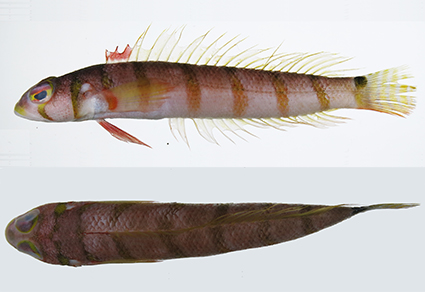Abstract
Two specimens of Parapercis moki Ho & Johnson were collected recently and detailed descriptions of their morphology and fresh coloration are provided. Its diagnosis is now revised as: band across head, six transverse bands on body and blade-like bar below eye; numerous small pores connected by canals forming about 9–10 vertical rows on cheek, opercle, and subopercle; scales on nape extending anteriorly to level of posterior margin of eyes; large spine on posteroventral corner of subopercle; very narrow interorbital space (1.7‒2.0% SL); 4 dorsal-fin spines, each spine progressively longer, last spine entirely connected by membrane to first dorsal-fin ray; four pairs of canine teeth anteriorly in lower jaw; and palatine teeth present, in two rows, and vomerine teeth stout, in two rows.
References
Ho, H.-C. (2014a) New record of whitespot sandperch Parapercis alboguttata (Günther, 1872) from Taiwan, with a key to sandperches of Taiwan. Platax, 11, 71‒81. https://doi.org/10.29926/PLATAX.201412_2014.0006
Ho, H.-C. (2014b) Redescription of Parapercis okamurai Kamohara, 1960 (Perciformes: Pinguipedidae), based on specimens newly collected from Taiwan and Japan. Zootaxa, 3857 (4), 581‒590. https://doi.org/10.11646/zootaxa.3857.4.7
Ho, H.-C. & Johnson, J.W. (2013) Redescription of Parapercis macrophthalma (Pietschmann, 1911) and description of a new species of Parapercis (Pisces: Pinguipedidae) from Taiwan. Zootaxa, 3620 (2), 273‒282. https://doi.org/10.11646/zootaxa.3620.2.5
Johnson, J.W. (2006) Two new species of Parapercis (Perciformes: Pinguipedidae) from north-eastern Australia, and rediscovery of Parapercis colemani Randall & Francis, 1993. Memoirs of Museum Victoria, 63 (1), 47‒56. https://doi.org/10.24199/j.mmv.2006.63.7
Randall, J.E., Senou, H. & Yoshino, T. (2008) Three new pinguipedid fishes of the genus Parapercis from Japan. Bulletin of the National Museum of Nature and Science, Series A (Zoology), Supplement 2, 69–84.


